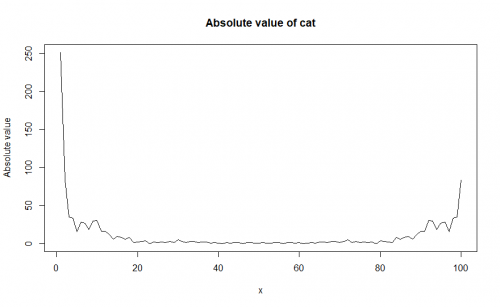26: Fourier
| Fourier |
| Original title: Wednesday's Drawing - Fourier |
 Title text: That cat has some serious periodic components |
This was the twenty-seventh comic originally posted to LiveJournal. The previous one was 25: Barrel - Part 4, and the next one was 27: Meat Cereals.
Explanation[edit]
A Fourier transform is a mathematical function transformation often used in physics and engineering. The theory is that any line graph can be represented as the sum of a bunch of sine waves of different frequencies and amplitudes. (The most obvious application is in analyzing a sound recording in terms of the different frequencies of sounds used.) So, for any line graph, you can produce another graph of the frequencies and their amplitudes. This can be done by evaluating an integral based on the function, which is referred to as "taking the Fourier transform" of the function. The form of the integral that needs to be taken is actually shown in the third line of the comic 55: Useless.
Unfortunately, Cueball has applied this "transform" to his cat. Indeed, whatever he has done has literally transformed his cat into the shape of an amplitude line graph. Although the cat seems to be alive and largely unharmed, it is clearly not in its familiar shape, and it is not clear if this condition is permanent or not. Notably, the fact the cat is still alive relates to an important property of Fourier transformation: the information of the original graph is fully preserved and can even be reversed to produce the original graph. How a reverse Fourier transformation would apply to a transformed cat has yet to be seen.
Cueball is, in this particular comic, likely Jon from Garfield. The name of Garfield's vet in the comic is Liz, and a recurring joke in that strip is Jon calling Liz to report various strange ailments befalling Garfield. "Periodic components" in the title text refers to the spikes in the graph. Because sine waves repeat themselves as you go along, the presence of large amounts of one particular sine wave in the Fourier transform graph (each spike) shows that the overall result (the initial graph) is likely to have parts that also repeat themselves, like a periodic function. In other words, the cat has repeating parts.
Transcript[edit]
- [Cueball is talking on the phone. A grotesque, spiky cat, who is apparently a Fourier transform, is looking at him.]
- Cueball: Hi, Dr. Elizabeth? Yeah, uh... I accidentally took the Fourier transform of my cat...
- Cat: Meow!
Trivia[edit]
- A user of this wiki, T7685, created the graph of the reverse Fourier transform of the cat in this comic. Unfortunately, they don't have the shape of a normal cat, because Randall didn't actually Fourier-transform a cat-like waveform. The resulting graphs are displayed below.
- David Zaslavsky published a fan version on his blog ellipsix informatics, interpreting the transformed cat.
Discussion
Isn't the cat also imaginary because its Fourier transform isn't symmetric?
I feel like there's another joke in that his cat is "imaginary" or has complex components.
Shdwdrgn (talk) 06:33, 8 October 2014 (UTC)shdwdrgn
Picking up on shdwdrgn's comment above, how interesting would the Fourier transform of Schroedingers's cat be. I guess it would consist of two overlaid graphs neither of which would be certain until you actually looked at it.EditorGonk (talk) 09:38, 20 July 2018 (UTC)
Might this also be a Garfield joke? Garfield's veterinarian is named Liz. Although Garfield, being roughly a three-dimensional ovoid, would probably end up with a much different looking Fourier transform than what is depicted here. --199.27.130.246 21:26, 9 October 2014 (UTC)
I think the transform may be of the movements of various parts of the cat. Cats tend to move their ears and heads a lot, and other parts, less so. What tipped me off is the spike at the tip of the tail. Cats typically twitch the very tip of their tail in a rhythmic fashion. 108.162.216.192 21:52, 2 March 2015 (UTC)
Coincidentially, the Fourier transform of a cat was used in a 2003 paper on the so-called phase problem in protein crystallography (figure 3) to illustrate the relevance of phase and amplitude information. See http://journals.iucr.org/d/issues/2003/11/00/ba5050/index.html and http://journals.iucr.org/d/issues/2003/11/00/ba5050/ba5050fig3.html
Can someone do a reverse fourier transform on the cat's graph and post it here please? --162.158.79.37 18:12, 14 July 2020 (UTC)Bumpf
I have done a fourier transform on the graph but sorry to report it's not that interesting. I can't figure out how to upload here so here's an imgur link https://imgur.com/a/APfAxLb (First time contributing sorry if I do something wrong)--T7685 (talk) 00:49, 10 March 2025 (UTC)
- You did great! Thank you for the graphs, I uploaded them myself and added them to the article! --FaviFake (talk) 15:40, 10 March 2025 (UTC)
In an attempt to find calculated fourier series of cats I found this gem: Interpreting Fourier transforms Wanderer Sinner (talk) 17:37, 27 March 2025 (UTC)
My guess is that if you shift the black part of the graph by -50, it will form the cat. 2A0D:3344:34CA:3110:7472:DB46:583D:B4A 07:25, 4 August 2025 (UTC)Unknown

